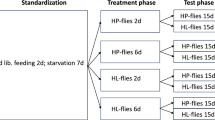Synopsis
Growth and survival of white sucker and pumpkinseed larvae were examined in the laboratory in relation to prey density. Mortality of both species was greatest during the transition from endogenous to exogenous nutrition. Mortality prior to yolk absorption was substantial for white suckers and was not related to prey density whereas, pumpkinseed mortality during the same period was low. After yolk absorption, however, pumpkinseed suffered considerably higher mortality rates than white sucker larvae and, in both species, mortality and growth were directly related to prey density. The minimum prey density supporting 10% survival of pumpkinseed larvae was estimated at 0.16 plankters ml-1 whereas, for white suckers it was 0.15 plankters ml-1. Significant growth of both white sucker and pumpkinseed larvae, however, occurred only at prey densities higher than 0.25 plankters ml-1. We suggest that since egg size and yolk reserve are greater in sucker larvae, suckers are better adapted to survive short term declines in prey abundance during the transition to exogenous feeding than pumpkinseed larvae. The reproductive strategies of each species seems to reflect this, with suckers spawning over a short time interval, but producing young with large yolk. Pumpkinseed, in contrast, spawn intermittently over an extended period but produce young with relatively small volk reserves.
Similar content being viewed by others
References cited
Auer, N.A. (ed.) 1982. Identification of larval fishes of the Great Lakes basin with emphasis on the Lake Michigan drainage. Great Lakes Fish. Comm., Ann Arbor, Spec. Pub. 82-3 744 pp..
Balon, E.K. 1984. Reflections on some decisive events in the early life of fishes. Trans. Amer. Fish. Soc. 113: 178–185.
Blaxter, J.H.S. 1962. The feeding of herring larvae and their ecology in relation to feeding. Calif. Coop. Oceanic Fish. Invest. Rep. 10: 79–88.
Blaxter, J.H.S. 1968. Rearing herring larvae to metamorphosis and beyond. J. Mar. Biol. Assoc. U.K. 48: 17–28.
Carlander, K.D. 1977. Handbook of freshwater fishery biology. Volume two. The Iowa State Univ. Press. Ames. 431 pp.
Cushing, D.H. 1976. Biology of fishes in the pelagic community, pp. 317–340.In: D.H. Cushing & J.J. Walsh (ed.) The Ecology of the Seas, W.B. Saunders & Co., Philadelphia.
Dahlberg, M.D. 1979. A review of survival rates of fish eggs and larvae in relation to impact assessments. Mar. Fish. Review 41: 1–12.
Hart, T.F. Jr. 1981. Growth and survival of larval white sucker (Catostomus commersoni) and pumpkinseed (Lepomis gibbosus) in relation to prey density. M.S. Thesis, SUNY College Environmental Science & Forestry, Syracuse. 73 pp.
Houde, E.D. 1975. Effects of stocking density and food density on survival, growth and yield of laboratory reared larvae of the sea breamArchosargus rhomboidalis (L.) (Sparidae). J. Fish Biol. 7: 115–127.
Houde, E.D. 1978. Critical food concentrations for larvae of three species of subtropical marine fishes. Bull. Mar. Sci. 28: 395–411.
Houde, E.D. & R.C. Schekter. 1980. Feeding by marine fish larvae: developmental and functional responses. Env. Biol. Fish. 5: 315–334.
Hunter, J.R. 1981. Feeding ecology and predation of marine fish larvae, pp. 34–77.In: R. Laker (ed.) Marine Fish Larvae, Morphology, Ecology and Relation to Fisheries, Washington, ea Grant Program, Seattle.
Kudrinskaya, O.M. 1970. Food and temperature as factors affecting the growth, development and survival of pike-perch larvae. J. Ichthyol. 10: 779–788.
Laurence, G.C. 1974. Growth and survival of haddock,Melanogrammus aeglefinus, larvae in relation to planktonic prey concentration. J. Fish. Res. Board Can 31: 1415–1419.
LeCren, E.D. 1951. The length-weight relationship and seasonal cycle in gonad weight and condition in the perch (Perca fluviatilis). J. Anim. Ecol. 20: 201–219.
May, R.C. 1971. Effects of delayed initial feeding on larvae of the grunion,Leuresthes tenuis (Ayres). U.S. Fish. Bull. 69: 411–425.
Noble, R.L. 1968. Mortality rates of pelagic fry of the yellow perch,Perca flavescens (Mitchill), in Oneida Lake, New York, and an analysis of the sampling problem. Ph.D. Thesis, Cornell University, Ithaca. 104 pp.
Ricker, W.E. 1973. Linear regressions in fishery research. J. Fish. Res. Board Can 30: 409–434.
Scott, W.B. & E.J. Crossman. 1973. Freshwater fishes of Canada. Bull. 184 Fisheries Res. Board Canada. 966 pp.
Siefert, R.E. 1972. First food of larval yellow perch, white sucker, bluegill, emerald shiner, and rainbow smelt. Trans. Amer. Fish. Soc. 101: 219–225.
Stewart, N.H. 1926. Development, growth, and food habits of the white sucker (Catostomus commersoni). U.S. Fish. Bull. 42: 147–184.
Toetz, D.W. 1966. The changes from endogenous to exogenous sources of energy in bluegill sunfish larvae. Invest. Indiana Lakes and Streams 7: 115–146.
Ware, D.M. 1975. Relation between egg size, growth, and natural mortality of larval fish. J. Fish. Res. Board Can 31: 2503–2512.
Werner, R.G. 1969. Ecology of limnetic bluegill (Lepomis macrochirus) fry in Crane Lake, Indiana. Amer. Midl. Nat. 81: 164–181.
Werner, R.G. & J.H.S. Blaxter. 1980. Growth and survival of larval herring (Clupea harengus) in relation to prey density. Can. J. Fish. Aquat. Sci. 37: 1063–1069.
Author information
Authors and Affiliations
Rights and permissions
About this article
Cite this article
Hart, T.F., Werner, R.G. Effects of prey density on growth and survival of white sucker,Catostomus commersoni, and pumpkinseed,Lepomis gibbosus, larvae. Environ Biol Fish 18, 41–50 (1987). https://doi.org/10.1007/BF00002326
Received:
Accepted:
Issue Date:
DOI: https://doi.org/10.1007/BF00002326




